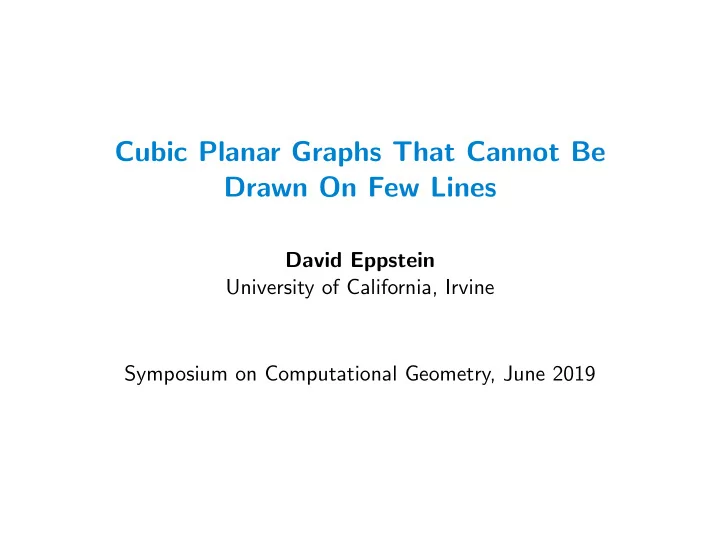

Cubic Planar Graphs That Cannot Be Drawn On Few Lines David Eppstein University of California, Irvine Symposium on Computational Geometry, June 2019
Planar graph drawing on one line Always possible using ≤ 2 semicircles per edge
Planar graph drawing on two lines Can draw graphs of arbitrarily high treewidth (here, a 6 × 6 grid) Can also draw all trees and all outerplanar graphs
Known graphs requiring non-constant lines, I Recursively subdivide triangles into 3 triangles Line through subdivision point misses a smaller triangle ⇒ needs Ω(log n ) lines even though treewidth ≤ 3 [Eppstein 2018]
From many-point lines to long dual paths In a planar graph whose faces are all triangles Line through k points ⇒ path of ≥ k − 1 edge-to-edge triangles (Doesn’t work for non-triangles — they can cross line > 1 time)
Known graphs requiring non-constant lines, II Find non-Hamiltonian 3-regular planar graph [Tutte 1946] [Eppstein 2014] Recursively replace vertices by copies of same graph ⇒ longest path O ( n 0 . 99 ) [Gr¨ unbaum and Walther 1973] Dualize ⇒ triangulated graph requiring Ω( n 0 . 01 ) lines [Ravsky and Verbitsky 2011; Chaplick et al. 2016, 2017]
An incorrect conjecture Conjecture [Firman et al. 2018] : 3-regular planar graphs can be drawn on 2 lines Counterexample (D.E.): (later verified computationally by Firman et al.)
Why is this a counterexample? One of the three red pentagons avoids both the crossing point of the two lines and the outer face of the whole drawing But it cannot be drawn only only two non-crossing line segments!
New results, I This graph requires Ω( n 1 / 3 ) lines (Rearrange hexagons ⇒ bounded pathwidth)
Why? For fewer lines, at least one hexagonal nest avoids all line crossings and the outer face But each level of nesting uses up one of the segments formed by the lines that cross its outer hexagon So it cannot be drawn on few lines without containing a crossing
New results, II This apex graph (tree + one vertex) requires Ω(log n ) lines (by similar reasoning)
Drawing apex-trees on O (log n ) lines x -coordinate = preorder y -coordinate = level in heavy path decomposition
Conclusions and new developments From this paper: ◮ Planar graphs with n vertices may require Ω( n 1 / 3 ) lines (even when 3-regular and bounded pathwidth) ◮ Series-parallel graphs and apex trees may require Ω(log n ) lines The apex-tree bound is tight, but what about series-parallel? More recently [Biedl et al. 2019] : ◮ NP-hard to find 2-line drawings ◮ 4-connected planar graphs can be drawn on O ( n 1 / 2 ) lines Can we close the gap between Ω( n 1 / 3 ) and O ( n 1 / 2 )?
References and image credits, I Therese Biedl, William Evans, Stefan Felsner, Sylvain Lazard, Henk Meijer, Pavel Valtr, Sue Whitesides, Steve Wismath, and Alexander Wolff. Line and plane cover numbers revisited. Manuscript, 2019. Steven Chaplick, Krzysztof Fleszar, Fabian Lipp, Oleg Verbitsky, and Alexander Wolff. Drawing graphs on few lines and few planes. In Yifan Hu and Martin N¨ ollenburg, editors, Graph Drawing and Network Visualization: 24th International Symposium, GD 2016, Athens, Greece, September 19–21, 2016, Revised Selected Papers , volume 9801 of Lecture Notes in Computer Science , pages 166–180. Springer, 2016. doi: 10.1007/978-3-319-50106-2 14 . Steven Chaplick, Krzysztof Fleszar, Fabian Lipp, Alexander Ravsky, Oleg Verbitsky, and Alexander Wolff. The complexity of drawing graphs on few lines and few planes. In Faith Ellen, Antonina Kolokolova, and J¨ org-R¨ udiger Sack, editors, Algorithms and Data Structures: 15th International Symposium, WADS 2017, St. John’s, NL, Canada, July 31 – August 2, 2017, Proceedings , volume 10389 of Lecture Notes in Computer Science , pages 265–276. Springer, 2017. doi: 10.1007/978-3-319-62127-2 23 .
References and image credits, II David Eppstein. A M¨ obius-invariant power diagram and its applications to soap bubbles and planar Lombardi drawing. Discrete & Computational Geometry , 52(3):515–550, 2014. doi: 10.1007/s00454-014-9627-0 . David Eppstein. Forbidden Configurations in Discrete Geometry . Cambridge University Press, 2018. Theorem 16.13. Oksana Firman, Fabian Lipp, Laura Straube, and Alexander Wolff. Examining weak line covers with two lines in the plane (poster abstract). In Graph Drawing and Network Visualization: 26th International Symposium, GD 2018, Barcelona, Spain, September 26–28, 2018, Revised Selected Papers , Lecture Notes in Computer Science. Springer, 2018. to appear. Branko Gr¨ unbaum and Hansjoachim Walther. Shortness exponents of families of graphs. Journal of Combinatorial Theory. Series A , 14: 364–385, 1973. doi: 10.1016/0097-3165(73)90012-5 .
References and image credits, III Alexander Ravsky and Oleg Verbitsky. On collinear sets in straight-line drawings. In Petr Kolman and Jan Kratochv´ ıl, editors, Graph-Theoretic Concepts in Computer Science: 37th International Workshop, WG 2011, Tepl´ a Monastery, Czech Republic, June 21–24, 2011, Revised Papers , volume 6986 of Lecture Notes in Computer Science , pages 295–306. Springer, 2011. doi: 10.1007/978-3-642-25870-1 27 . W. T. Tutte. On Hamiltonian circuits. Journal of the London Mathematical Society , 21(2):98–101, 1946. doi: 10.1112/jlms/s1-21.2.98 .
Recommend
More recommend